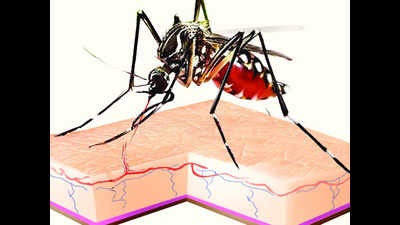- News
- City News
- Hyderabad News
- With four-pronged attack, dengue now a major challenge for Telangana
Trending
This story is from October 24, 2018
With four-pronged attack, dengue now a major challenge for Telangana
With all four strains of dengue stinging Hyderabad and other parts of Telangana, the disease is fast emerging as a major health challenge for authorities.

Representative image
HYDERABAD: With all four strains of dengue stinging Hyderabad and other parts of Telangana, the disease is fast emerging as a major health challenge for authorities. Apart from its regular symptoms, respiratory distress has been reported in at least four per cent of dengue cases, central nervous system (CNS) problems in another four per cent, and bleeding issues in as many as 36 per cent of cases.The mortality rate for the disease is currently estimated at about six per cent.
Recent research studies by different teams of city doctors including those from Osmania Medical College reveal that co-circulation of the four strains of dengue has become common in Hyderabad and other parts of the two Telugu states. While debilitating fever is noticed in all the dengue patients, only some reported other symptoms related to brain, liver and lungs. Dengue cases tend to increase between the months of August to November.
A study by Osmania Medical College team showed that 56 per cent of patients had headache, 42 per cent body pains, 36 per cent joint pains, 26 per cent rashes on the skin and six per cent had jaundice. Three types of dengue fevers were noticed in the city. They are dengue haemorrhagic fever (DHF) in 36 per cent, common dengue fever in 56 per cent and dengue shock syndrome in eight per cent. Six per cent of the patients had died due to complications.
A study by V Lakshmi Deepa and S Rajendra Prasad, published in the Journal of Medical Research, revealed that more men than women had dengue. The infection is seen in all age groups, particularly between 14 and 69 years. Those in their 30s were more prone to the dengue infection. The bleeding issues ranged from red rashes to bleeding gums to blood in urine to internal bleeding.
Recent research studies by different teams of city doctors including those from Osmania Medical College reveal that co-circulation of the four strains of dengue has become common in Hyderabad and other parts of the two Telugu states. While debilitating fever is noticed in all the dengue patients, only some reported other symptoms related to brain, liver and lungs. Dengue cases tend to increase between the months of August to November.
A study by Osmania Medical College team showed that 56 per cent of patients had headache, 42 per cent body pains, 36 per cent joint pains, 26 per cent rashes on the skin and six per cent had jaundice. Three types of dengue fevers were noticed in the city. They are dengue haemorrhagic fever (DHF) in 36 per cent, common dengue fever in 56 per cent and dengue shock syndrome in eight per cent. Six per cent of the patients had died due to complications.
A study by V Lakshmi Deepa and S Rajendra Prasad, published in the Journal of Medical Research, revealed that more men than women had dengue. The infection is seen in all age groups, particularly between 14 and 69 years. Those in their 30s were more prone to the dengue infection. The bleeding issues ranged from red rashes to bleeding gums to blood in urine to internal bleeding.
Another study by K Jahnavi of Malla Reddy Institute of Medical Sciences and T Sreenivasulu of Patnam Mahender Reddy Institute of Medical Sciences revealed that bleeding would occur when the count of platelets falls below 50,000 cells per cubic millimetre.
End of Article
FOLLOW US ON SOCIAL MEDIA











